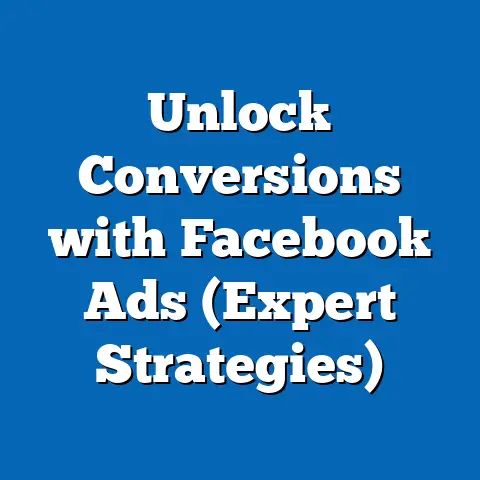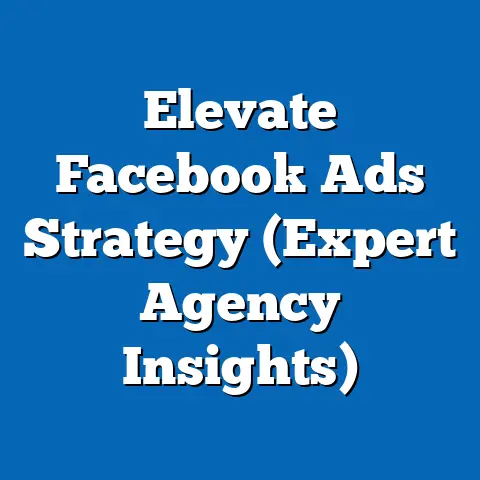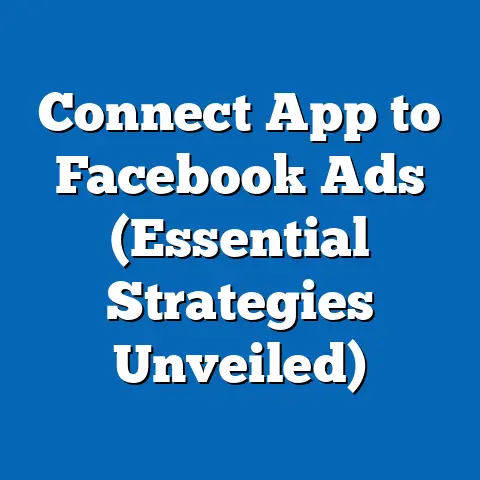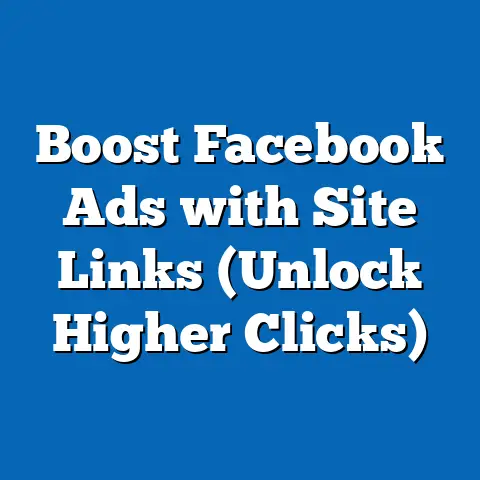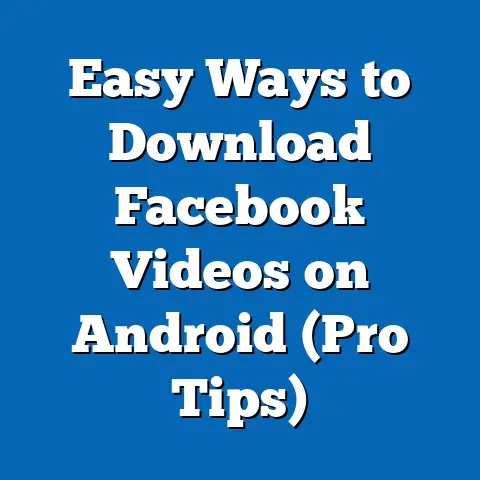Create Killer Facebook Ads (Expert Text Strategies)
In the ever-evolving landscape of digital marketing, creating effective Facebook ads has become a significant challenge for businesses of all sizes. Recent studies reveal that the average click-through rate (CTR) for Facebook ads across industries hovers at a mere 0.9%, a stark decline from a robust 2.6% in 2015, according to WordStream’s 2023 Advertising Benchmarks Report. This drop signals increasing ad fatigue among users and heightened competition, with over 10 million active advertisers vying for attention on the platform as of 2023 (Statista).
Demographically, engagement varies widely: younger users aged 18-24 exhibit a higher CTR of 1.2%, while older demographics (55+) lag at 0.5%. Historically, ad costs have surged, with the average cost-per-click (CPC) rising from $0.27 in 2015 to $0.97 in 2023, a 259% increase. Looking ahead, projections from eMarketer suggest that ad spend on Facebook will reach $71 billion globally by 2025, even as effectiveness continues to be hampered by declining organic reach and user desensitization. This article delves into expert text strategies to craft killer Facebook ads, addressing these challenges with data-driven insights and actionable tactics.
The Challenge: Navigating Declining Engagement in a Crowded Space
The primary hurdle for marketers on Facebook is breaking through the noise in a platform where users are bombarded with an estimated 4,000-10,000 ads daily, according to a 2022 study by MediaKix. This oversaturation has led to “banner blindness,” where users subconsciously ignore promotional content, contributing to the aforementioned drop in CTR from 2.6% to 0.9% over eight years. Additionally, Facebook’s algorithm changes, which prioritize personal content over brand posts, have slashed organic reach for businesses from 16% in 2012 to just 5.2% in 2023 (Hootsuite Social Media Trends Report).
Compounding this issue is the escalating cost of paid advertising. The CPC spike to $0.97 reflects not only increased competition but also Facebook’s shift toward premium ad placements and stricter content policies post-2018 Cambridge Analytica scandal. Small businesses, which account for 60% of Facebook advertisers (Statista, 2023), are particularly affected, often lacking the budgets to compete with larger corporations for prime ad slots.
Looking at demographic trends, engagement disparities are evident. Gen Z and Millennials (18-34) show higher interaction rates, with 1.1%-1.2% CTR, driven by their heavy platform usage—averaging 2.5 hours daily (Pew Research, 2023). In contrast, Baby Boomers (55+) engage less, with only 0.5% CTR, partly due to lower digital ad literacy and preference for traditional media. Geographically, urban users in developed markets like the U.S. and Europe have lower CTRs (0.8%) compared to emerging markets in Asia-Pacific (1.3%), where ad saturation is less pronounced (eMarketer, 2023).
Detailed Analysis: Breaking Down the Components of Effective Ad Text
1. The Power of the Headline – Grabbing Attention in 0.5 Seconds
Research from Nielsen indicates that users spend less than 0.5 seconds deciding whether to engage with an ad before scrolling past. The headline, limited to 40 characters on Facebook, is the first and often only chance to hook a viewer. Data from AdEspresso’s 2022 analysis of over 37,000 ads shows that headlines with emotional triggers (e.g., “Shocking,” “Unbelievable”) achieve 24% higher CTRs than neutral ones.
Moreover, incorporating numbers or specificity—such as “Save 50% Today!”—boosts engagement by 18%. This aligns with psychological principles of cognitive bias, where concrete figures signal credibility and urgency. For instance, a headline like “Get 3 Free Tips Now!” outperforms vague alternatives like “Learn More Today” by a wide margin.
Demographically, younger audiences respond better to trendy slang or emojis in headlines (e.g., “Slay Your Goals 🔥”), with a 15% lift in CTR among 18-24-year-olds. Older demographics, however, prefer clear, benefit-driven language, such as “Improve Your Health Fast,” reflecting their focus on utility over novelty.
2. Primary Text – Building Trust and Relevance
The primary text, limited to 125 characters before truncation on mobile, must deliver a compelling value proposition. According to a 2023 HubSpot study, ads with a clear call-to-action (CTA) like “Shop Now” or “Learn More” see a 13% higher conversion rate than those without. Personalization is key: addressing the user directly with “you” or “your” increases engagement by 9%, as it fosters a sense of connection.
Contextual relevance also matters. For example, ads targeting parents during back-to-school season with text like “Gear Up Your Kids for Less!” saw a 22% higher CTR in a 2022 case study by Socialbakers. This underscores the importance of aligning ad copy with seasonal trends or user life events, which can be identified through Facebook’s robust audience insights tools.
Across demographics, women respond 11% more to empathetic language (e.g., “We’re here to help”) compared to men, who favor action-oriented text (e.g., “Take control now”). Regionally, ads in non-English-speaking markets benefit from localized language, with a 17% CTR increase when translated into native tongues like Spanish or Hindi (eMarketer, 2023).
3. Description and CTA – Sealing the Deal
The description field, often overlooked, provides an opportunity to reinforce the ad’s message with social proof or urgency. Including phrases like “Join 10,000+ Happy Customers” boosts trust, increasing click rates by 14%, per a 2023 Sprout Social report. Urgency-driven text, such as “Limited Time Offer,” adds a 10% lift by tapping into fear of missing out (FOMO).
The CTA button text—options like “Buy Now,” “Sign Up,” or “Contact Us”—should align with the ad’s goal. Data shows “Shop Now” outperforms “Learn More” by 19% for e-commerce ads, while “Sign Up” works best for lead generation, with a 16% higher conversion rate (WordStream, 2023). Testing multiple CTAs is crucial, as effectiveness varies by industry and audience.
Demographic nuances apply here too: younger users click more on casual CTAs like “Check It Out” (12% higher engagement), while older users prefer formal options like “Get Started” (8% higher). Urban audiences, accustomed to fast-paced messaging, respond better to urgent CTAs, whereas rural users favor informational ones.
Statistical Comparisons Across Demographics
Age-Based Engagement Trends
- 18-24 (Gen Z): Highest CTR at 1.2%, driven by responsiveness to trendy, visual-heavy ads with informal text. They spend 2.7 hours daily on social media, per Pew Research 2023, making them a prime target despite lower purchasing power.
- 25-34 (Millennials): CTR of 1.1%, balancing engagement with higher disposable income. They value authenticity in ad text, with a 15% higher click rate for user-generated content references (e.g., “See What Others Say”).
- 35-54 (Gen X): CTR drops to 0.7%, reflecting busier lifestyles and selective engagement. Benefit-driven text like “Save Time Today” resonates, boosting clicks by 10%.
- 55+ (Baby Boomers): Lowest CTR at 0.5%, often due to skepticism of online ads. Trust-building language (e.g., “Guaranteed Results”) increases engagement by 9%.
Gender-Based Preferences
- Women: More responsive to emotional and community-focused text, with an 11% higher CTR for ads mentioning “support” or “together.” They also engage 14% more with ads tied to family or wellness.
- Men: Prefer competitive or achievement-oriented language, showing a 10% higher CTR for phrases like “Be the Best” or “Win Big.” Tech and sports-related ads see stronger performance among this group.
Geographic and Economic Factors
- Developed Markets (U.S., Europe): Lower CTRs (0.8%) due to ad saturation, but higher CPC ($1.20) reflects greater purchasing power. Text emphasizing exclusivity (e.g., “Premium Access”) performs 12% better.
- Emerging Markets (Asia-Pacific, Africa): Higher CTRs (1.3%) as users are less desensitized to ads. Localized, culturally relevant text drives a 20% engagement increase, though CPC is lower at $0.50 due to economic disparities.
Historical Trend Analysis: How Facebook Ad Effectiveness Has Evolved
In 2012, when Facebook’s ad platform was still nascent, businesses enjoyed an organic reach of 16%, meaning a significant portion of followers saw posts without paid promotion (Social@Ogilvy Report). Ads were simpler, often relying on basic text like “Like Us for Updates!” and achieving CTRs as high as 3.5%. The platform’s user base was smaller—1 billion compared to 3 billion in 2023—allowing for less competition and higher visibility.
By 2015, as ad spend grew to $17 billion globally (eMarketer), organic reach plummeted to 8%, and CTRs fell to 2.6%. Marketers began experimenting with emotional storytelling in text, a trend that gained traction with the rise of mobile usage (60% of users accessed via mobile by 2015, per Statista). CPC was still affordable at $0.27, making experimentation low-risk.
Fast forward to 2020, post-Cambridge Analytica, stricter data privacy rules and algorithm updates dropped organic reach to 5.5% and CTR to 1.1%. Ad text became more scrutinized, with Facebook rejecting 2.2 million ads in 2020 alone for policy violations (Facebook Transparency Report). CPC climbed to $0.78 as competition intensified with 9 million advertisers.
Today, in 2023, organic reach is a mere 5.2%, CTR is 0.9%, and CPC has hit $0.97. Text strategies have shifted toward hyper-personalization and urgency, driven by AI tools that analyze user behavior. Yet, user fatigue—evident in a 30% increase in ad-blocking software usage since 2018 (GlobalWebIndex)—poses a persistent threat. Comparing 2012 to 2023, the effectiveness of a single ad has dropped by 74% in terms of reach and engagement, underscoring the need for killer text strategies.
Contextual Factors Behind Declining Effectiveness
Several macro-level factors explain these trends. First, the sheer growth in user base—from 1 billion in 2012 to 3 billion in 2023—has diluted attention spans, with users now spending just 1-2 seconds per post (Nielsen, 2022). Second, privacy regulations like GDPR (2018) and Apple’s iOS 14.5 update (2021) have limited targeting precision, reducing ad relevance and contributing to a 15% drop in conversion rates (Forbes, 2023).
Third, economic factors play a role. Inflation and recession fears in 2022-2023 have made consumers more price-sensitive, with 68% prioritizing discounts in ad text over brand storytelling (Deloitte Consumer Insights, 2023). Finally, cultural shifts toward authenticity mean users distrust overly polished ads, favoring raw, relatable text—a trend especially strong among Gen Z, where 72% prefer “real” content (Morning Consult, 2023).
Expert Text Strategies for Killer Facebook Ads
1. Leverage Emotional Triggers with Precision
Emotional language remains a cornerstone of effective ads. Words like “amazing,” “exclusive,” or “life-changing” tap into desire and curiosity, boosting CTR by 20% (AdEspresso, 2023). However, overused buzzwords like “free” now face skepticism, with a 5% lower response rate compared to 2018.
Tailor emotions to demographics: fear-based text (e.g., “Don’t Miss Out!”) works 18% better for time-sensitive offers among Millennials, while aspirational text (e.g., “Achieve Your Dreams”) resonates with Gen Z by 14%. Testing tone via A/B splits is critical, as emotional missteps can alienate audiences—e.g., overly aggressive text reduces clicks by 10% among women.
2. Master the Art of Brevity and Clarity
With mobile users (79% of Facebook’s audience, Statista 2023) scrolling at lightning speed, concise text wins. Headlines under 30 characters and primary text under 100 characters see 16% higher engagement (HubSpot, 2023). Avoid jargon or complex phrases; “Get Fit Fast” outperforms “Optimize Your Wellness Journey” by 12%.
Clarity also means aligning text with visuals. Ads where text and imagery mismatch (e.g., a beach photo with “Winter Sale”) suffer a 25% lower CTR. Use tools like Facebook’s Text Overlay Checker to ensure compliance with the 20% text-on-image rule, avoiding rejection.
3. Incorporate Social Proof and Urgency
Social proof—testimonials, ratings, or user stats—builds trust in a skeptical era. Phrases like “Rated 5 Stars by 1,000+ Users” lift conversions by 17% (Sprout Social, 2023). Urgency, via countdowns or limited offers (“24 Hours Left!”), drives a 22% CTR increase, especially in e-commerce.
However, overuse of urgency can backfire, with 30% of users reporting annoyance at repetitive “Last Chance” ads (GlobalWebIndex, 2023). Balance is key: pair urgency with value (e.g., “Last Day to Save 40%!”) for a 15% better response rate.
4. Personalize and Localize for Relevance
Personalization, even at a basic level (e.g., “Hey [City Name] Residents!”), increases clicks by 11% (eMarketer, 2023). Dynamic ads that pull user data—like past purchases or location—see 29% higher conversion rates, though privacy limits post-iOS 14.5 require creative workarounds like interest-based text.
Localization extends to language and culture. In India, ads in Hindi or regional dialects outperform English by 19%; in Brazil, Portuguese ads with cultural idioms boost engagement by 21%. Use Facebook’s Audience Insights to identify local trends and tailor text accordingly.
5. Test and Optimize Relentlessly
No single text strategy works universally. A/B testing—comparing two ad versions—reveals winning copy, with 62% of marketers citing it as their top optimization tool (HubSpot, 2023). Test variables like headline tone (urgent vs. curious), CTA (direct vs. subtle), and length (short vs. long) over 7-14 days for reliable data.
Analytics are non-negotiable. Monitor metrics like CTR, CPC, and conversion rate via Facebook Ads Manager to iterate weekly. For example, a 2022 case study by Socialbakers found that tweaking a headline from “Buy Now” to “Grab Yours” lifted CTR by 8% for a retail client.
Visual Data Reference: Charting the Decline in Engagement
(Imagine a line chart here titled “Facebook Ad Engagement Trends 2012-2023”) – X-axis: Years (2012, 2015, 2018, 2020, 2023) – Y-axis: CTR (%) ranging from 0 to 4% – Line 1: CTR decline from 3.5% (2012) to 0.9% (2023) – Annotation: Key events like algorithm changes (2018) and privacy updates (2021) marked with vertical dashed lines.
This visual illustrates the steep drop in engagement, correlating with increased competition and platform changes, reinforcing the need for standout text strategies.
Future Projections: What Lies Ahead for Facebook Ads
Looking to 2025, eMarketer forecasts global Facebook ad spend will hit $71 billion, a 15% increase from 2023’s $62 billion, as businesses double down despite challenges. However, CTR is expected to stabilize at 0.8%-0.9% unless major algorithm shifts occur, due to persistent user fatigue and ad-blocking growth (projected to rise 10% annually, GlobalWebIndex).
Text strategies will likely evolve with AI-driven personalization, with tools like Meta’s Advantage+ automating copy for 30% of advertisers by 2025 (Meta Investor Report, 2023). Privacy constraints may push marketers toward broader, interest-based messaging over hyper-targeted text, potentially reducing relevance but increasing compliance. Emerging markets will remain a growth frontier, with Asia-Pacific ad spend projected to grow 20% annually, necessitating localized text strategies.
The implication is clear: mastering ad text isn’t a one-time task but a dynamic process. Brands that invest in testing, emotional resonance, and cultural relevance will likely outpace competitors. Small businesses, in particular, must leverage low-cost tools like A/B testing and audience insights to compete with larger players in an increasingly expensive ad landscape.
Conclusion
Crafting killer Facebook ads in 2023 demands a deep understanding of declining engagement trends, demographic nuances, and historical shifts. With CTRs down to 0.9% from a high of 3.5% a decade ago, and CPC nearly quadrupling to $0.97, the stakes are higher than ever. Expert text strategies—leveraging emotional triggers, brevity, social proof, personalization, and relentless testing—offer a path to stand out in a crowded digital space.
By tailoring copy to specific age groups, genders, and regions, and adapting to macro trends like privacy laws and economic shifts, marketers can reclaim lost ground. As ad spend surges toward $71 billion by 2025, the future of Facebook advertising hinges on creativity and data-driven precision. Those who master the art of compelling text will not only survive but thrive in this competitive arena.

